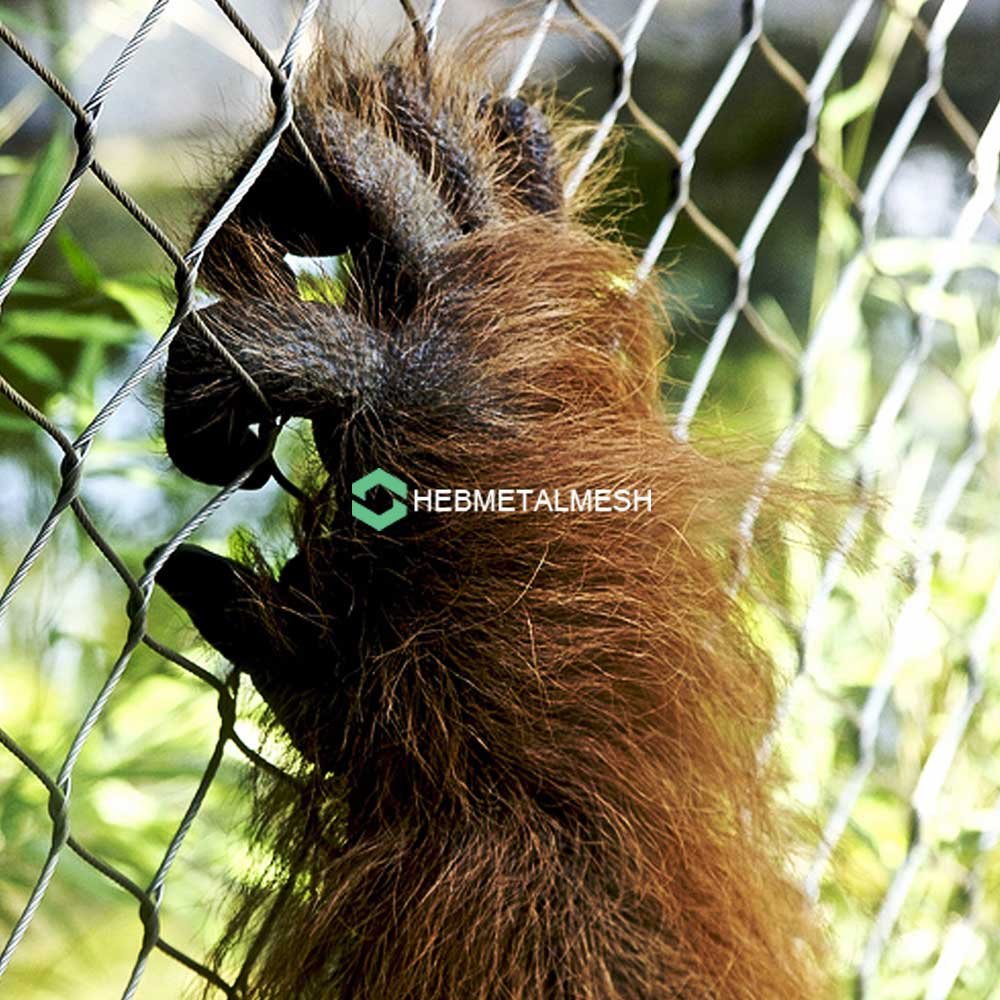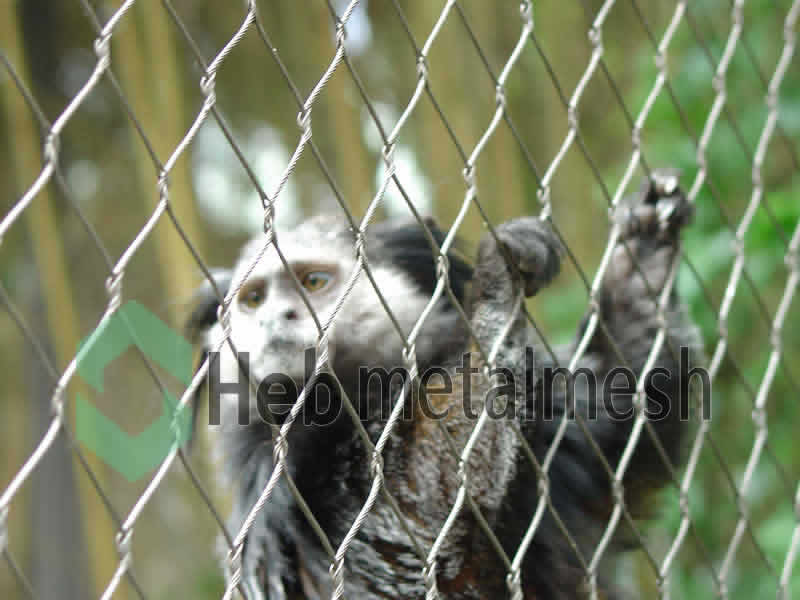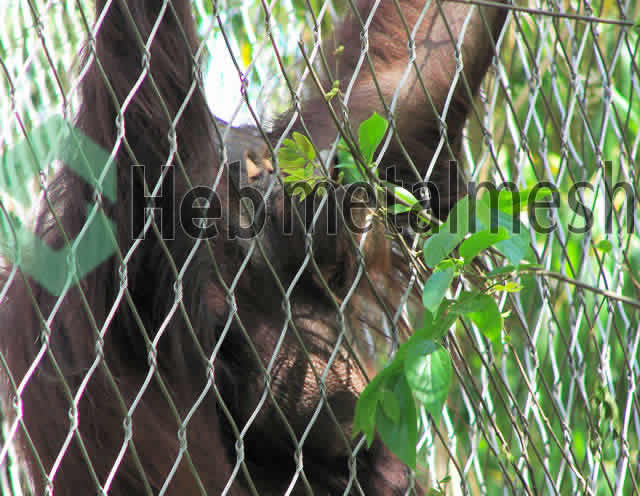Introduction to Handwoven Mesh
Handwoven mesh is an innovative and versatile material that has gained popularity in various fields, particularly in zoo enclosure designs. This unique type of mesh is composed of durable materials that ensure both strength and flexibility. One of its most notable components is stainless steel, which is celebrated for its resistance to corrosion and tensile strength. The combination of these properties makes handwoven mesh an ideal choice for environments that demand longevity and safety, particularly in settings housing exotic animals.
In the construction of handwoven mesh, multiple strands of high-quality stainless steel wires are interlinked, creating a robust yet lightweight structure. This interweaving process not only enhances the aesthetic appeal but also provides a high level of protection against potential breaches. The seamless and continuous nature of handwoven mesh differs significantly from traditional fencing materials such as chain-link fences or wooden barriers, which can degrade over time and require frequent maintenance.
Moreover, handwoven mesh offers advantages in terms of visibility and airflow. Unlike opaque barriers, the transparent nature of handwoven mesh allows visitors to observe animals without obstruction, fostering a more engaging experience. Simultaneously, the open design promotes natural airflow within the enclosure, contributing to a healthier environment for the animals. This aspect is particularly important for species that require specific climate conditions to thrive.
The adaptability of handwoven mesh extends beyond appearance and functionality; it can be customized to fit various enclosure sizes and designs, further enhancing its suitability for modern zoos. As conservation efforts evolve, the demand for innovative materials such as handwoven mesh is likely to increase, reinforcing its integral role in contemporary zoo architecture. Ultimately, handwoven mesh stands as a testament to the inventive solutions being utilized to create safe, aesthetically pleasing, and animal-friendly habitats.
Why Stainless Steel? The Material Benefits
Stainless steel has emerged as a premier material in the construction of handwoven mesh used in zoo enclosures, thanks to its unique properties that significantly enhance durability and functionality. One of the standout features of stainless steel is its impressive resistance to corrosion. Enclosures are often subjected to diverse environmental conditions, including rain, humidity, and varying temperatures. This resistance ensures that the handwoven mesh maintains its structural integrity and aesthetic appeal over time, providing a long-lasting solution without the frequent need for replacement or repairs.
In addition to corrosion resistance, stainless steel is renowned for its exceptional strength and durability. The material can withstand significant wear and tear, which is essential in environments where animals may exert force against the enclosure. This durability minimizes the risk of breaches, ensuring the safety of both the animals and the public. Handwoven mesh made from stainless steel can accommodate the weight and movement of various species, making it a reliable choice for diverse zoo habitats.
An important consideration in any outdoor application is maintenance. Stainless steel mesh is relatively low maintenance compared to other materials. It does not require frequent painting or anti-corrosive treatments, thereby reducing the overall maintenance costs associated with zoo enclosure upkeep. This characteristic is particularly advantageous for zoological institutions that aim to allocate their resources efficiently while ensuring a safe environment for their inhabitants.
Moreover, the modern aesthetics of stainless steel blends seamlessly with natural surroundings, enhancing the visual appeal of zoo enclosures. This integrates functionality with design, creating spaces that are both inviting for visitors and secure for animals. By leveraging the benefits of stainless steel for handwoven mesh applications, zoos can achieve reliable, sustainable, and attractive enclosures that meet the highest safety standards.
Designing Zoo Enclosures with Handwoven Mesh
Handwoven mesh has emerged as a pivotal element in the design and construction of modern zoo enclosures. The versatility of this material allows for the creation of secure environments that prioritize the safety of both the animals housed within and the visitors exploring the exhibits. Utilizing a variety of weaving techniques and materials, designers can customize handwoven mesh to meet the specific needs of different species, providing enclosures that not only meet safety standards but also enhance animal welfare.
One of the key benefits of handwoven mesh is its ability to offer unobstructed views of the animals. Unlike traditional fencing, which can create barriers that detract from the visitor experience, handwoven mesh allows for a seamless visual connection. Visitors can engage more deeply with the animals, facilitating educational opportunities while also fostering a sense of appreciation for wildlife. Additionally, the aesthetic appeal of the mesh can be tailored to each exhibit, contributing to the overall theme and atmosphere of the zoo.
From large animals such as elephants and big cats to smaller species, the flexibility of handwoven mesh accommodates various enclosure designs. It can be used to create suspended habitats or to form natural barriers that blend into the surroundings, offering a more immersive experience for guests. Furthermore, the durability of handwoven mesh ensures that enclosures withstand the elements and the natural behaviors of the animals, thereby reducing maintenance needs over time. This longevity contributes to a sustainable approach in zoo design.
Moreover, safety is paramount in the design of zoo enclosures. Handwoven mesh can be tailored to meet specific security protocols, ensuring that it adequately contains animals while preventing escape or potential accidents. This balance of functionality and aesthetics makes handwoven mesh an increasingly popular choice in the evolution of zoo enclosure designs, demonstrating its significance in creating engaging and secure wildlife habitats.
Aesthetic Appeal: Nature and Black Oxide Finishes
The visual aspect of zoo enclosure designs plays a pivotal role in creating an immersive experience for visitors while ensuring the well-being of the animals within. One element that significantly contributes to this aesthetic appeal is handwoven mesh. Its intricate patterns and natural appearance mimic the textures found in their wild habitats, providing an aesthetically pleasing enclosure that feels organic and engaging. The delicate craftsmanship of handwoven mesh can seamlessly blend into various environments, from lush, tropical settings to arid landscapes, enhancing the overall visual coherence of the zoo.
In addition to its natural look, the option of a black oxide finish on handwoven mesh brings an alluring sophistication to the structures. This particular finish not only serves a functional purpose, such as corrosion resistance, but also adds depth and contrast to the design. The dark tone allows the mesh to harmoniously integrate with existing architectural features, landscaping, and the animals themselves, whilst subtly drawing the attention of visitors without overshadowing the creatures on exhibit. The combination of natural textures and sleek finishes creates an appealing juxtaposition that captivates the onlooker’s eye.
The use of handwoven mesh with black oxide finishes can create visually stunning enclosures that spark curiosity and interest in both young and adult visitors alike. Such attention to aesthetic details enhances the overall experience of the zoo, making it a more memorable place. Furthermore, properly designed enclosures can facilitate the enrichment of animals, as the aesthetics contribute to a more dynamic and engaging habitat, supporting the animals’ behavioral needs. Consequently, the successful integration of handwoven mesh and its finishes plays a vital role in zoo enclosure designs, where beauty and functionality must coexist harmoniously.
Free Roll Sizes: Customization and Flexibility
One of the defining features of handwoven mesh is its availability in various free roll sizes. This aspect of customization addresses the diverse needs of animal enclosures by allowing designers and builders to select specific dimensions that align perfectly with the structure’s requirements. The flexibility in roll sizes means that professionals can approach each project with a tailored strategy, maximizing both efficiency and aesthetic appeal.
The capacity to utilize different roll sizes plays a crucial role in the construction of enclosures for various species. Some animals benefit from expansive habitats that require wider spans of mesh, while others may need more precisely measured materials to accommodate their specific behavioral and spatial needs. Handwoven mesh, which can be cut and configured on-site, lends itself to a practical solution. Thus, a more effective and harmonious living environment can be created for the animals.
Moreover, this adaptability in design presents opportunities for innovative structures that can enhance the overall visitor experience in zoos. Custom roll sizes enable architects and designers to implement unique visual aspects that differentiate each enclosure, utilizing the aesthetic qualities of the handwoven mesh to create engaging spaces. Such structures not only cater to the physical requirements of the animals but also add to the educational value and visual appeal for zoo visitors.
The combination of customized roll sizes and the natural durability of handwoven mesh results in a sustainable option for zoo enclosures. This material typically requires less frequent replacements and repairs, thereby reducing long-term operational costs. The flexibility in employing different sizes ensures that projects can be executed with a higher degree of precision, ultimately contributing to the functional and visual success of animal exhibits. As a result, handwoven mesh stands out as an essential component in modern zoo enclosure design, marrying adaptability with performance.
Safety Considerations in Zoo Design
The safety of both animals and visitors is paramount in the design of zoo enclosures. Incorporating handwoven mesh into these designs presents various advantages that address concerns around escape prevention, animal welfare, and visitor safety. One of the primary benefits of using handwoven mesh is its ability to deter animals from breaching their enclosures. Due to its robust nature, particularly when crafted from high-quality materials such as stainless steel, this type of mesh offers a strong barrier that is difficult for animals to manipulate or escape through. The structural integrity of handwoven mesh ensures that even the most determined species remain securely contained, thereby protecting them and the public alike.
Animal welfare is also significantly enhanced through the use of handwoven mesh in zoo enclosures. This material allows for ample ventilation and visibility, which are crucial for the well-being of the animals. The gentle interweaving of the mesh creates a safe environment where animals can interact with their surroundings without feeling overly confined. Furthermore, the visibility provided by the mesh fosters a sense of connection between the animals and visitors, which is essential for encouraging education and empathy towards wildlife.
Visitor safety is another critical aspect that must be addressed in zoo design. Handwoven mesh provides a transparent yet secure barrier that allows for close-up views of the animals while ensuring that individuals remain at a safe distance. This design minimizes the risk of unwanted interactions between humans and animals, thus significantly reducing potential hazards. The resilience of stainless steel handwoven mesh also meets strict safety standards, further cementing its role in creating secure, aesthetically pleasing zoo enclosures. In conclusion, the integration of handwoven mesh in zoo design is not only a matter of aesthetics but a decisive factor in enhancing safety measures for both animals and visitors.
Sustainability and Environmental Impact
The increasing emphasis on sustainability within zoo enclosure designs has led to the adoption of innovative materials such as stainless steel handwoven mesh. This particular material not only fulfills aesthetic requirements but also provides substantial environmental benefits. One of the most notable features of stainless steel is its recyclability. When zoo enclosures reach the end of their service life, the handwoven mesh can be fully recycled, thus minimizing waste and promoting a circular economy. This recycling capability is in stark contrast to traditional materials that may contribute to landfill waste or require significant resources for disposal.
Furthermore, stainless steel handwoven mesh boasts remarkable durability and longevity compared to other materials used in zoo construction. This resilience means that enclosures require fewer repairs or replacements over time, significantly reducing the demand for new materials and the environmental footprint associated with their production. Instead of replacing enclosures frequently, zoos can invest in quality structures that last for decades, effectively aligning with sustainable practices while ensuring animal safety and comfort.
Additionally, the use of such robust materials in zoo enclosures contributes to improved maintenance protocols. Stainless steel handwoven mesh does not corrode easily, especially when compared to ferrous materials that may deteriorate when exposed to weather and animal interactions. This characteristic reduces maintenance needs and the associated resources consumed for upkeep. Ultimately, the integration of handwoven mesh in zoo designs aids in promoting sustainable operations, fostering a landscape where environmental responsibility is at the forefront of modern zoo management. By prioritizing these materials, zoos can not only enhance their aesthetic appeal but also set an example in the global effort towards environmental conservation.
Case Studies: Successful Implementations of Handwoven Mesh
Various zoos around the world have embraced the unique qualities of handwoven mesh in their enclosure designs. These implementations not only address visual appeal but also significantly enhance the welfare of the animals as well as the experience of visitors. One notable example is the use of handwoven mesh in the San Diego Zoo, where the installation of this material for the enclosure of sloths allowed for unrestricted air circulation and natural lighting. The custom design of the mesh provided an optimal environment for the sloths, mimicking their natural habitat while ensuring visibility for guests. Encounters with these animals became more engaging as visitors had unobstructed views without the interference of heavy barriers.
Furthermore, the Berlin Zoo embarked on an innovative project that utilized handwoven mesh in its aviary sections. Here, the lightweight yet durable characteristics of the mesh played a critical role in both safety and aesthetics. Birds were freer to fly, with the mesh effectively preventing them from escaping while allowing sunlight to permeate the enclosure, which is vital for the health of the avian species. This design not only improved the physical well-being of the birds but also enriched the visitor experience by providing a serene environment that felt more connected to nature.
In Africa, the Johannesburg Zoo adopted handwoven mesh barriers for several enclosures, particularly for large felines. These custom creations addressed specific challenges such as the need for non-intrusive barriers that would not obstruct the animals’ movements or behaviors. The handwoven mesh effectively minimizes stress in the animals by providing a secure environment while maintaining high visibility for guests. The successful integration has sparked interest among other facilities looking to enhance animal welfare and improve visitor interactions, demonstrating the growing recognition of the benefits of handwoven mesh in zoo enclosure designs.
Future Trends and Innovations in Zoo Enclosure Design
The landscape of zoo enclosure design is poised for significant evolution, particularly with the incorporation of handwoven mesh materials. As public attitudes shift towards more humane and naturalistic habitats for animals, architects and designers are exploring innovative solutions to enhance both aesthetic appeal and functionality. Among these, advanced materials such as stainless steel mesh are emerging as frontrunners due to their durability, flexibility, and safety features. This evolution not only caters to the needs of the animals but also elevates the visitor experience.
One of the notable trends is the integration of bio-inspired designs that mimic the animals’ natural environments. Handwoven mesh, with its intricate patterns and textures, provides a unique opportunity to create visually captivating enclosures that resonate with the habitats of various species. Additionally, the use of such mesh allows for a seamless view, ensuring that visitors can observe animals without intrusive barriers. This enhancement fosters an educational experience that promotes conservation awareness among zoo-goers.
Furthermore, the future may see advancements in materials technology that could revolutionize how handwoven mesh is used. Innovations such as weather-resistant coatings could prolong the lifespan of these enclosures in diverse climates, while new lightweight composites may facilitate easier management and maintenance. Designers could leverage these advancements to create more elaborate structures that are both cost-effective and environmentally sustainable.
Moreover, the adoption of smart technology in zoo design is on the rise. Incorporating sensors and monitoring systems within handwoven mesh enclosures could allow for real-time observation of animal behavior, health, and interaction patterns. This integration will not only ensure the wellbeing of the animals but will also provide invaluable data for conservationists and researchers.
In conclusion, the future of zoo enclosure design is bright with possibilities, particularly with the promising role of handwoven mesh. As we strive for more humane, engaging, and ecologically responsible spaces, the innovations in materials and technology will undoubtedly pave the way for a new era in humane animal exhibitions.


